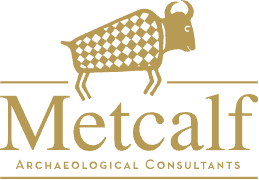What did the buffalo say to his son when he dropped him off at archaeology field school?
Bi-son!
The first Saturday of November holds a special place in our hearts here at Metcalf – it’s National Bison Day! When creating our logo, we wanted something that would unite the strength and self-determination of the bison with the creative and unique artistry of the Mimbres peoples. To celebrate National Bison Day, we will look at the creation of Mimbres pottery and the history of the US national mammal.
Mimbres Pottery
The Mimbres region, Spanish for “Little Willow”, is located in the American Southwest. Sharing their name with the river that runs through the area, the Mimbres are known for their incredibly expressive black and white clay pottery, especially bowls decorated with a variety of figural and geometric designs.
Mimbres pottery production began around AD 600, with thousands of these bowls created up until the dissolution of Mimbres society in AD 1150. While there were many bowls created, it seemed they were not traded, as the pottery was rarely discovered outside Mimbres sites. Bowls have been found in human burials and are used to cover the face or head of the deceased. The different sizes of bowls suggest multiple functions other than serving and eating. Bowls have been found in human burials and are used to cover the face or head of the deceased. These same bowls have a “kill hole” in the middle, possibly as a way for a spirit to rise out.
When looking at the bowls from the outside, they seem plain, with little to no detail. However, when looking inside the pottery, it’s realized the magic is on the inside. Some items contained intricate geometric lines and patterns. However, the most common decorations were images of animals such as fish, rabbits, deer, and antelope. The beautiful black decorations on a white background make the Mimbres peoples unique. No other Southwestern peoples created vessels with such individuality. Unfortunately, extensive looting targeted at finding and selling Mimbres pottery destroyed many of the region’s sites over the last century. However, archaeologists continue to work to rehabilitate and protect these sites.
![Mimbres Pottery © President and Fellows of Harvard College, Peabody Museum of Archaeology and Ethnology, [24-15-10/94468 + 60740376] A pot found at Swarts Ranch depicts a hunter returning home with a deer.](https://metcalfarchaeology.com/wp-content/uploads/2021/11/Mimbres-Pottery.jpeg)
(©President and Fellows of Harvard College, Peabody Museum of Archaeology and Ethnology, [24-15-10/94468 + 60740376])
A pot found at Swarts Ranch depicts a hunter returning home with a deer.
The U.S. National Mammal
Bison, buffalo, whatever you want to call them, bison are the national mammal of the United States! Their shaggy coats and enormous size (they’re the largest mammals in the US) make them an extremely recognizable and symbolic animal of the Great Plains. The largest bison population is in Yellowstone National Park. Over 4,900 bison call Yellowstone home! This herd of bison is highly important because they are pure descendants (free of cattle genes) of the early bison that roamed the U.S. grasslands.
In prehistoric times, there were 30-60 million bison that roamed the plains. Bison were critically important to Plains Indians societies. They relied on buffalo heavily for survival and their wellbeing and used every part of the bison for food, clothing, shelter, tools, jewelry and ceremonies. However, as European settlers pushed west, bison numbers declined rapidly. There were military directives to destroy bison in order to control Native Americans. The massacre of millions of bison in the 1800s was pivotal in the tragic destruction of Native peoples and societies. From over 30 million to about 300 left in the wild, bison were on the brink of extinction. Eventually, the American Bison Society was formed by Theodore Roosevelt and other conservationists to save the majestic animals.
Today, bison live in all 50 states and many tribal nations. There are over 500,000 bison, making their place on the endangered species list very low. In 2016, Congress voted to make the bison our national mammal. This recent act represents yet another historic event in one of the greatest conservation success stories of all time.

A bison watching over a calf at Yellowstone National Park. Calves are called “red dogs”. Photo by Diana LeVasseur
Metcalf Logo
With the creation of our logo, we wanted something that symbolized the creativity, strength, and uniqueness of Metcalf. The bison characterizes the resilience and unity Metcalf strives to achieve, and the Mimbres design represents Metcalf’s desire to be ethical and effective stewards of cultural heritage across the US. As a 100% employee-owned company driven to uncover and care for remnants of the human experience through applied sciences and public education, a bison decorated with Mimbres-inspired art continues to symbolize our more than 40 years of excellent work in cultural resource management.

Sources
“15 Facts about Our National Mammal: The American Bison.” U.S. Department of the Interior, 29 Sept. 2021, https://www.doi.gov/blog/15-facts-about-our-national-mammal-american-bison.
“American Bison: National Geographic.” Animals, https://www.nationalgeographic.com/animals/mammals/facts/american-bison.
Bradford, Alina. “Facts about Bison.” LiveScience, Purch, 26 Aug. 2017, https://www.livescience.com/60241-bison-facts.html.
“Mimbres Bowl.” Metmuseum.org, Met Museum, https://www.metmuseum.org/art/collection/search/310575.
“Who or What Is Mimbres?” Archaeology Southwest, 30 Mar. 2021, https://www.archaeologysouthwest.org/free-resources/fact-sheets/who-or-what-is-mimbres/.
